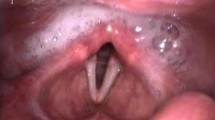Abstract
Background
Residual food (RF) during esophagogastroduodenoscopy (EGD) is thought, but not proven, to be a risk factor for gastric-to-pulmonary aspiration.
Aims
The aims of this study were to determine the prevalence of RF during EGD, to investigate whether RF was associated with an increased risk of aspiration, especially when monitored anesthesia care (MAC) or general anesthesia (GA) were administered, and to determine whether aspiration associated with RF led to a more severe clinical outcome.
Methods
Patients undergoing EGD between October 2012 and September 2018 were identified. Patient age, sex, aspiration events, RF, sedation type, structural foregut abnormalities, and diagnoses associated with impaired esophageal or gastric motility were noted. The clinical course after an aspiration event was evaluated.
Results
RF was identified during 4% of 81,367 EGDs. Aspiration events occurred during 41 (5/10,000) procedures. Aspiration was more likely to occur in patients with RF (odds ratio [OR] 15.1) or those receiving MAC or GA (OR 9.6 and 16.8 relative to conscious sedation, respectively). RF and MAC/GA were synergistically associated with increased odds of aspiration. In a multivariate nominal logistic regression model, older age (OR 2.6), MAC (OR 3.8), GA (OR 4.4), vagotomy (OR 5.2), achalasia (OR 3.8), and RF (OR 10.0) were risk factors for aspiration. Aspiration events in the presence or absence of RF led to similar clinical outcomes.
Conclusions
While aspiration events are rare in patients undergoing EGD, RF and the use of MAC or GA were associated with substantially increased odds of aspiration.

Similar content being viewed by others
Abbreviations
- CI:
-
Confidence interval
- EGD:
-
Esophagogastroduodenoscopy
- GA:
-
General anesthesia
- MAC:
-
Monitored anesthetic care
- OR:
-
Odds ratios
- RF:
-
Retained food
References
Peery AF, Crockett SD, Murphy CC et al. Burden and cost of gastrointestinal, liver, and pancreatic diseases in the United States: update 2021. Gastroenterology. 2022;162:621–644.
Bohman JK, Jacob AK, Nelsen KA et al. Incidence of gastric-to-pulmonary aspiration in patients undergoing elective upper gastrointestinal endoscopy. Clin Gastroenterol Hepatol. 2018;16:1163–1164.
American Society of Anesthesiologists. Practice guidelines for preoperative fasting and the use of pharmacologic agents to reduce the risk of pulmonary aspiration: application to healthy patients undergoing elective procedures: an updated report by the American Society of Anesthesiologists Task Force on preoperative fasting and the use of pharmacologic agents to reduce the risk of pulmonary aspiration. Anesthesiology. 2017;126:376–393.
Bi D, Choi C, League J, Camilleri M, Prichard DO. Food residue during esophagogastroduodenoscopy is commonly encountered and is not pathognomonic of delayed gastric emptying. Dig Dis Sci. 2020. https://doi.org/10.1007/s10620-020-06718-0.
Friedrich K, Scholl SG, Beck S et al. Respiratory complications in outpatient endoscopy with endoscopist-directed sedation. J Gastrointest Liver Dis JGLD. 2014;23:255–259.
El Chafic AH, Eckert G, Rex DK. Prospective description of coughing, hemodynamic changes, and oxygen desaturation during endoscopic sedation. Dig Dis Sci. 2012;57:1899–1907. https://doi.org/10.1007/s10620-012-2057-z.
von Elm E, Altman DG, Egger M, Pocock SJ, Gøtzsche PC, Vandenbroucke JP. The strengthening the reporting of observational studies in epidemiology (STROBE) statement: guidelines for reporting observational studies. Lancet (London, England). 2007;370:1453–1457.
Warner MA, Warner ME, Weber JG. Clinical significance of pulmonary aspiration during the perioperative period. Anesthesiology. 1993;78:56–62.
Cowley LE, Farewell DM, Maguire S, Kemp AM. Methodological standards for the development and evaluation of clinical prediction rules: a review of the literature. Diagn Progn Res. 2019;3:16.
Sakai T, Planinsic RM, Quinlan JJ, Handley LJ, Kim TY, Hilmi IA. The incidence and outcome of perioperative pulmonary aspiration in a university hospital: a 4-year retrospective analysis. Anesth Analg. 2006;103:941–947.
Olsson GL, Hallen B, Hambraeus-Jonzon K. Aspiration during anaesthesia: a computer-aided study of 185,358 anaesthetics. Acta Anaesthesiol Scand. 1986;30:84–92.
Lienhart A, Auroy Y, Péquignot F et al. Survey of anesthesia-related mortality in France. Anesthesiology. 2006;105:1087–1097.
Bouvet L, Desgranges FP, Aubergy C et al. Prevalence and factors predictive of full stomach in elective and emergency surgical patients: a prospective cohort study. Br J Anaesth. 2017;118:372–379.
Smith I, Kranke P, Murat I et al. Perioperative fasting in adults and children: guidelines from the European Society of Anaesthesiology. Eur J Anaesthesiol. 2011;28:556–569.
Brady M, Kinn S, Stuart P. Preoperative fasting for adults to prevent perioperative complications. Cochrane Database Syst Rev. 2003;2003:Cd004423.
Exarhos ND, Logan WD, Abbott OA, Hatcher CR. The importance of pH and volume in tracheobronchial aspiration* *from the Division of Thoracic and Cardiovascular Surgery, Emory University School of Medicine. Dis Chest. 1965;47:167–169.
James CF, Modell JH, Gibbs CP, Kuck EJ, Ruiz BC. Pulmonary aspiration–effects of volume and pH in the rat. Anesth Analg. 1984;63:665–668.
Schwartz DJ, Wynne JW, Gibbs CP, Hood CI, Kuck EJ. The pulmonary consequences of aspiration of gastric contents at pH values greater than 2.5. Am Rev Respir Dis. 1980;121:119–126.
Knight PR, Rutter T, Tait AR, Coleman E, Johnson K. Pathogenesis of gastric particulate lung injury: a comparison and interaction with acidic pneumonitis. Anesth Analg. 1993;77:754–760.
Acknowledgments
The authors would like to thank Ms. Danette Bruns and the Anesthesia Clinical Research Unit for assistance with data extraction.
Funding
None.
Author information
Authors and Affiliations
Corresponding author
Ethics declarations
Conflict of interest
The authors declare that they have no conflict of interest.
Additional information
Publisher's Note
Springer Nature remains neutral with regard to jurisdictional claims in published maps and institutional affiliations.
Supplementary Information
Below is the link to the electronic supplementary material.
Rights and permissions
About this article
Cite this article
Feighery, A.M., Oblizajek, N.R., Vogt, M.N.P. et al. Retained Food During Esophagogastroduodenoscopy Is a Risk Factor for Gastric-to-Pulmonary Aspiration. Dig Dis Sci 68, 164–172 (2023). https://doi.org/10.1007/s10620-022-07536-2
Received:
Accepted:
Published:
Issue Date:
DOI: https://doi.org/10.1007/s10620-022-07536-2




